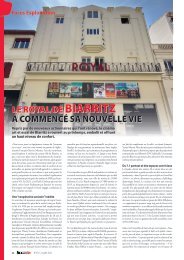Create successful ePaper yourself
Turn your PDF publications into a flip-book with our unique Google optimized e-Paper software.
PROJEQION AND SOUND<br />
00<br />
Easy-To-Foliow<br />
Directions<br />
For Servicing Amplifiers<br />
by WESLEY TROUT<br />
%m KT S TAKE UP<br />
in this issue, and the<br />
next several issues of<br />
Modern Theatre,<br />
step-by-step simplified<br />
amplifier servicing<br />
data. Audio amplifiers<br />
are not so<br />
complex that you will<br />
have a hard time understanding<br />
the cir-<br />
(.u.:^ \\'c will ^t.ut with an amplifier circuit<br />
using not so many tube elements and<br />
advance, later, into more complex circuits<br />
of the modern theatre amplifier. With a<br />
little study of text books on the subject,<br />
such as radio and audio amplifiers servicing,<br />
and data that will be presented in this<br />
department, I am sure you will obtain a<br />
good working knowledge of theatre sound<br />
systems.<br />
KEEP COOL AND THINK<br />
Trouble-shooting requires ordinary Intelligent<br />
thinking, keeping cool and working<br />
systematically. A thorough understanding<br />
of his equipment is a "must" for every<br />
projectionist desiring knowledge on general<br />
maintenance of sound and projection<br />
equipment. A competent projectionist, in<br />
my opinion, is one mentally alert, eager to<br />
learn more about good sound and projection,<br />
how to service such equipment. Regardless<br />
of whether the theatre has sound<br />
service or not—he must be prepared for<br />
trouble and know fairly well what to do!<br />
If sound goes off suddenly or volume suddenly<br />
decreases, there is not too much time<br />
for prolonged reflection—the show must go<br />
on as quickly as possible. Don't entirely<br />
depend on your service engineer for many<br />
minor troubles, because he may be several<br />
hundred miles from your city and it would<br />
take time to get there. If you have a fair<br />
knowledge of servicing sound and still can't<br />
clear the trouble up completely, you can<br />
'phone him, and he will tell you what the<br />
cause may be. You can, by acquiring servicing<br />
knowledge in this department and<br />
text books, more intelligently understand<br />
his instructions and quickly clear up the<br />
trouble.<br />
GOOD TEST INSTRUMENTS IMPORTANT<br />
The modern theatre amplifier is ruggedly<br />
buUt, contains components well constructed,<br />
having plenty of capacity to carry<br />
voltages, etc. It is a very fine, delicate<br />
piece of equipment. Don't use cheap test<br />
instruments for trouble shooting—they are<br />
practically useless for checking circuits as<br />
most of them draw too much current. Buy<br />
your equipment from a reliable source so<br />
it will give dependable service and true<br />
readings. Indispensable Is a good, high Internul-resl.stance,<br />
multlple-ranKe, combination<br />
voltmeter-miUlammcler; next hlKh<br />
quality, high-resistance hciidi)honps. If you<br />
don't have the nece.s.sary equipment for<br />
checklnR circuits, it may take you hours to<br />
find an open or short, defective condenser,<br />
resistor or choke. Good voltmeter is absolutely<br />
necessary for checking your power<br />
supply. Power supply and tubes should<br />
always be checked first! A good tube checker<br />
is of paramount importance in any projection<br />
room.<br />
USE<br />
HIGHEST RANGE<br />
Next In importance is to take care of this<br />
equipment so it wlU always be ready for<br />
instant use. Always use the highest range<br />
on meter, if you don't know how high the<br />
voltage is in the circuit you are testing<br />
it will be safer and avoid damaging your<br />
Instrument.<br />
An output meter is very useful for testing<br />
focus of sound lens and running transmission<br />
tests. The unit of power output of<br />
: •<br />
•: ."' Ut-clbeh or<br />
uay umpiiticr i.-> in' ><br />
watLn, but engine*-! li-clxb a.s the<br />
more convfiilenl unit for .vjund m'-a^urfmi-nl-H<br />
Moat muHl-ranKi- voltmi-t'r.\ have<br />
drclUU on the scale. U th«y mrt quality<br />
Instruments.<br />
A reel of good musical recording Is excellent<br />
for testing the system, from time to<br />
time, for quality reproduction, a general<br />
check on all frequencies. A number of sixfoot<br />
test loops for checking sound lens<br />
focus, lateral guide adjustment and a<br />
•buzz" track loop. A few good frequency<br />
test records are excellent, but I favor a<br />
reel with various lest frequencies to the<br />
records, I find pluno recordings best for<br />
checklns flutter in a sound head.<br />
SERVICING AUDIO AMPLIFIERS<br />
It generally doe.s not pay to try to repair<br />
resistors as they are inexpensive and<br />
not worth the time expended—such repairs<br />
should only be made for emergency purposes.<br />
Molded-carbon and metallized fixed<br />
resistors should be replaced with new ones<br />
when they become defective as they can<br />
seldom be repaired to give permanent service.<br />
Some times carbon resistors, if overheated<br />
for a long period of time, become<br />
carbonized, and they should be replaced<br />
immediately with a new resistor of similar<br />
resistance but with a much higher wattage<br />
rating, so it will not overheat. Bear in mind<br />
when such component Is not heavy enough<br />
POWERSTAT<br />
PROVIDE<br />
BIG<br />
TIME<br />
LIGHTING CONTROL<br />
ON A SMALL T<br />
IPS<br />
Modtm light dimming wjuipmtnt n»«d not b«<br />
•xp«niiv«. Thi» wo» conclujivtiv d«monitrat«d<br />
by Lawr«nc« Voii, a m«mber ot th» faculty<br />
ot Southern Illinois Univtrjity, wh«n h« built<br />
o 25,000 watt, pr«s«t, proporiional dimming,<br />
completely flexible, portable switchboard ot o<br />
moterioli cost of opproximotely $1,200. Ma>t«f<br />
dimming is achieved by foyr 5,000 watt<br />
POWERSTAT Dimmers. The flexibility, th« consistent<br />
performance, the unusual economy of<br />
POWERSTAT Dimming Equipment put big lime<br />
ghting control within lh» reach of very<br />
mited budgets.<br />
Write for the complet* tloryj tofl«»h»f ¥Hth<br />
pictures and drowingt, of In* iwitchbeord<br />
built by Mr. Voss.<br />
2/22 DfMfRS AVENUE, BRISTOL. CONN<br />
m SUPERIOR ELECTRIC co.<br />
Continued on tollowing page<br />
BOXOFnCE December 8, 1863 31<br />
^g

















